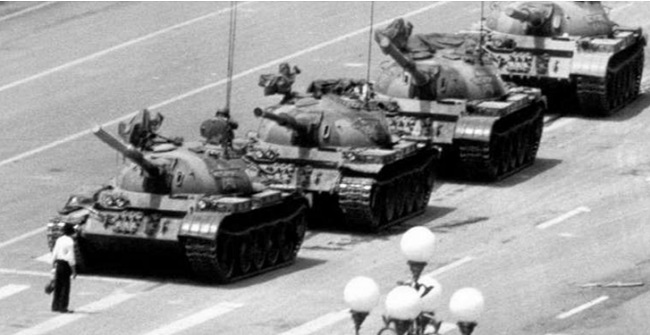



Communism started from Lenin’s October Revolution and spread to China with Mao Zedong’s rise to power and to Cuba, with Fidel Castro’s takeover. It was the ideology behind one side of the Cold War and saw a symbolic decline with the fall of the Berlin Wall. Communism has carried out a large number of crimes not only against individual human beings but also against world civilization and national cultures. It isn’t in every case simple to recognize events caused by fighting between rulers and rebels and events that can appropriately be described only as a massacre of the civilian population.
This is the History of this Communist party for which power, commanded through the gun, is more important than anything, even the lives of their citizens do not matter for the Party. This is the story of 1980s, when China was going through huge changes. The ruling Communist Party started to permit some private companies and foreign investment while at the same time raising hopes for greater political openness.
The story of Tiananmen Square incident
The story of Tiananmen Square incident, also called June Fourth incident which started from April 15, 1989, people from across China gathered in Beijing’s Tiananmen Square to mourn the death of General Secretary of the Communist Party and the popular reformist leader Hu Yaobang who had promoted economic and political reform, but was ousted by his conservative opponents. The next day, at Tiananmen Square, thousands of students gathered and Hu Yaobang had become a symbol of reform for the student movement.
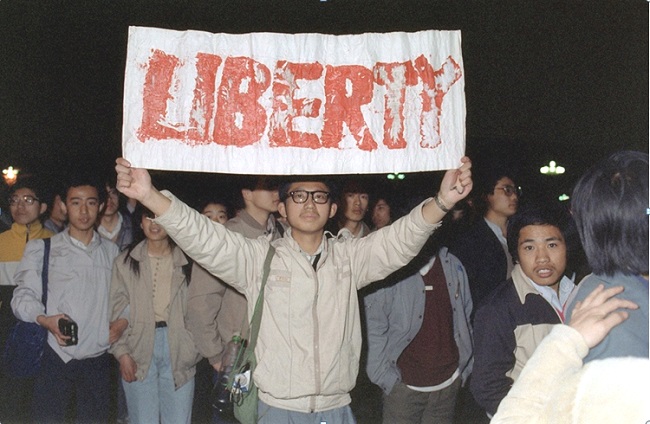
((A student displays a banner with one of the slogans chanted by the crowd of some 200,000 pouring into Tiananmen Square, on April 22, 1989 in Beijing.))
Tiananmen means “gate of heavenly peace”, Tiananmen Square is located in the centre of Beijing, the capital of China. Two days after the death of Hu, several hundred students marched to Tiananmen Square and laid a wreath at the Monument to the People’s Revolutionary Heroes. They called for more noteworthy right to speak freely, financial opportunities and curbs o corruption – demands that touched a raw nerve with the conservatives in the Communist Party. The top initiative was partitioned; while some saw students as patriotic, others considered them to be a danger to regime. The demonstrations spread to hundreds of cities across China. Meanwhile, an intense debate ensued among government and party officials on how to handle the mounting protests. Moderates such as Zhao Ziyang (Hu Yaobang’s successor as party general secretary), tried to mitigate the damage by indicating his willingness to hold a dialogue with the students in a speech on 4 May.
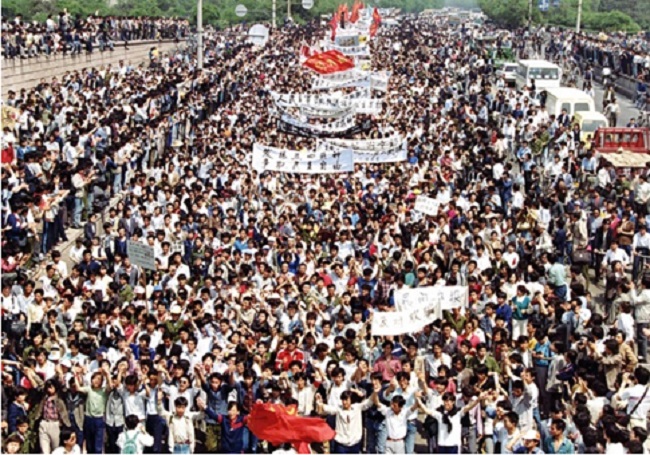
((Thousands of students from local colleges and universities marched to Tiananmen Square, Beijing, on May 4, 1989, to demonstrate for government reform))
On May, 13th just two days before the arrival of Soviet leader, Mikhail Gorbachev for a state visit, hundreds of student protesters in Tiananmen Square went on hunger strike in order to speak push for talks with Communist Party leaders. However, they were overruled by hard-liners led by Chinese premier Li Peng and supported by paramount elder statesman Deng Xiaoping, who, fearing anarchy, insisted on forcibly suppressing the protests.
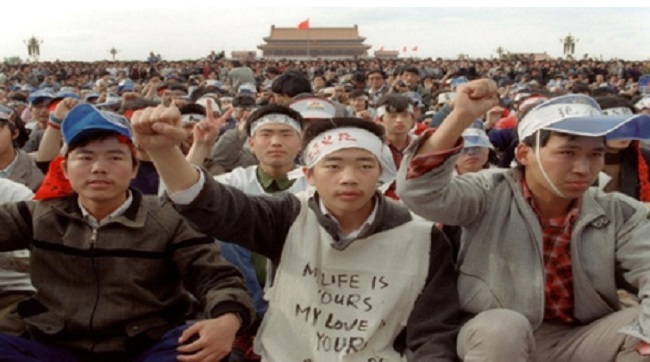
((Students from Beijing University stage a huge demonstration in Tiananmen Square as they start an unlimited hunger strike.))
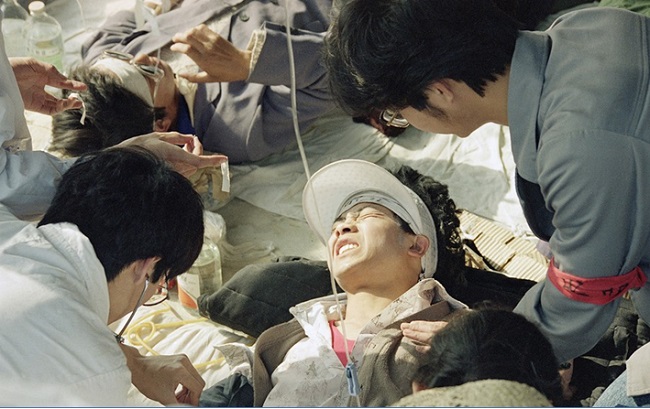
((A striking Beijing University student is given first aid by medics at a field hospital in Tiananmen Square, on May 17, 1989, the fourth day of their hunger strike for democracy.))
As the estimation made, one million people joined the protests in Beijing to express their support for the students on hunger strike and to demand reform which further followed by a rally with an estimation of 1.2 million people and the presence of General Secretary of the Chinese Communist Party, Zhao Ziyang, who pleads for an end to the demonstrations. Zhao was later purged and lived under house arrest until his death in 2005. During the last two weeks on May 19th, 1989 martial law was declared in Beijing by Li Peng, Troops moved in, but were blocked by the civilians and demonstrations continued, western journalists also maintained a presence there, often providing live coverage of the events. On June 1st, The Communist Government halts live American news telecasts in Beijing, including CNN. Also reporters are prohibited from capturing or recording any of the demonstrations or Chinese troops. A reported 100,000 people attend a concert in Tiananmen Square by singer Hou Dejian, in support of the demonstrators on June 2nd, 1989.
Over night of 3 to 4 June at about 1 a.m. Chinese troops launched a two-pronged attack from the east and west of Beijing. . The government wanted to ‘restore order’ in the capital, with orders to put down the protests, crushing some protesters and firing on many others, even they gave no warning before they started shooting. As the troops kept firing into the crowds, some of those running away were shot in the back. Others were crushed to death by military vehicles. No one knows the death toll from Tiananmen that night.
After 4 June – Black Day
The Tiananmen protests were immortalized in Western media on 5 June through the image, a Chinese man stands alone to block a line of tanks heading east on Beijing’s Cangan Boulevard in Tiananmen Square, on June 5, 1989. The man, calling for an end to violence and bloodshed against pro-democracy demonstrators, Tank Man would not let the military vehicles pass. He succeeded. Eventually, he was pulled out of the way of danger by onlookers. But the image of unarmed man versus tank quickly came to symbolize the struggle of the Tiananmen protesters – peaceful protest met with military might.
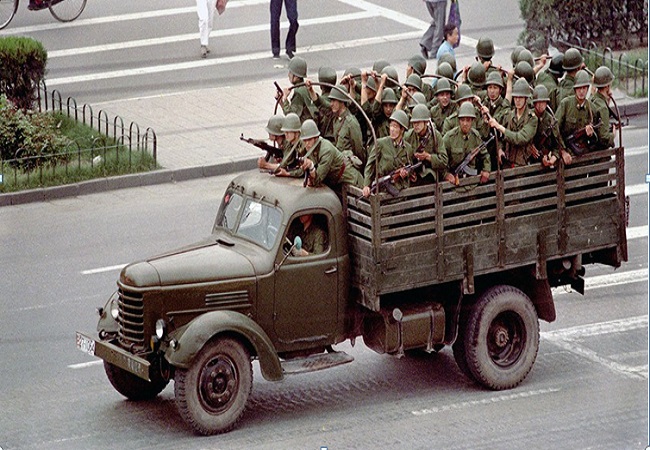
((A truck drives Chinese soldiers down Chang’an Boulevard in Beijing, on June 5, 1989, one day after violence between government troops and pro-democracy protesters left hundreds dead.))

Following the military crackdown, the Chinese specialists started to hunt down those involved in the demonstrations. A large number of individuals were detained, tortured, imprisoned or executed after unfair trials charged with ‘counter-revolutionary’ crimes. The Chinese authorities have never revealed the all out number of individuals confined, attempted or executed all through China since the June 1989 crackdown. Tiananmen and the 1989 crackdown remains an official taboo topic in China. In the climate of fear which followed the massacre, the family members of those executed were not just incapable to look for equity for their misfortune; they were even unfit to grieve straightforwardly the dead, who were formally portrayed as ‘rioters’.
The National Security Archive publishes “Tiananmen Square, 1989 on June 1, 1999: The Declassified History. The archive includes US State Department documents related to the events that took place during the demonstrations. On January 2001, Two Chinese scholars publish “The Tiananmen Papers” amid controversy. The papers are presented as a collection of internal government documents including transcriptions of notes, speeches, meeting minutes and eyewitness accounts of the historical disaster. The Chinese government calls the papers fabricated material. Former journalist Yu Dongyue is released from prison after serving 17 years. He was arrested during the Tiananmen Square protests for throwing paint at a portrait of Mao Zedong in February, 2006. On June 04, 2009 Tens of thousands of people commemorate the 20th anniversary of Tiananmen Square at a gathering in Hong Kong. In Beijing, journalists are barred from the square while the government blocks foreign news sites and Twitter. The National Museum of China in Tiananmen Square is newly renovated and open to the public. The building contains no exhibits mentioning the events of June 1989 in April, 2011. In 2012, Wuer Kaixi, one of the organizers of the Tiananmen Square protest, attempts to return to China by turning himself over to the Chinese embassy in Washington, DC. The embassy does not answer the door. Only recently a court in Changshu in eastern China found Gu Yimin guilty of inciting state subversion after he tried to post images of the post-Tiananmen crackdown online and applied to stage a protest on the 24th anniversary. On June 03, 2016 Twenty-six years after the uprising in Tiananmen Square, a State Department Spokesperson issues a statement calling for the release of those still serving “Tiananmen-related sentences.” China is set to release Miao Deshun, the last known prisoner of the uprising, according to Dui Hua, a San Francisco-based human rights organization on June 15, 2016.
Communist modus operandi
“Every communist must grasp the truth, ‘Political power grows out of the barrel of a gun’. Our Principal is that the Party commands the gun, and the gun must never be allowed to command the Party”, these are the words of Mao Zedong, the first authoritarian leader of Chinese Communist Party (CCP). Many archives and witnesses prove conclusively that terror has always been one of the basic ingredients of modern Communism[1]. In the three decades since Tiananmen, the Communist Party has dismissed calls for political liberalization, tightened its control on discourse and intensified its suppression of dissent to keep up soundness and to maintain its own endurance. The repudiation of political transparency ushered in an era of rampant corruption, inequality and social instability. The Chinese government has since justified its military crackdown on the movement as necessary for political stability, economic prosperity and its eventual rise. In the 13th National People Congress, the top legislative boy, which works on the dictates of the Politburo of the CCP, a Civil Code consisting of six parts rights was introduced first time ever. Now the question is: Is it nothing but superficial dressing to the deep wounds as it is combined with a formation of “small group” of the Xi Jinping’s close confidants to take care of the ‘Prevent and crackdown on activities that endanger the political security of the country’? It has always been seen, either in the name of Cultural Revolution or Restructuring or saving political stability through Tiananmen Square massacre, wherever there is a dissent in China against the Communalism, both Chinese people and the surroundings areas suffer. It has the tradition of Communism China of covering up the “state secrets” to hide the exact figure of abnormal death. We can see Communism in all forms is brutal and violent. An example, Hong Kong has been witnessing a prolonged pro-democracy protest against the violent subjugation by China. With Communist China replacing the ‘one country, two systems’ with ‘one country, one system’, will democracy and freedom of expression in the region cease to exist? Law of jungle still prevails in Tibet by Communist China as the bigger fish goes on eating the smaller fish, with no protest from the world.
Conclusion
Is it the problem that lies in the party or its ideology? Is it the democracy or so called people’ democracy that has been people centric but always centered on Party and Power? Can brutal ideology kill the citizens of his country? Is it wrong to silently protest to ask for democracy? Is it wrong to demand democracy? Were all those students who protested silently and being attacked by Chinese troops without any warning guilty? Posts relating to the massacres are regularly removed from the internet, tightly controlled by the government. So, for a younger generation who didn’t live through the protests, there is little awareness about what happened and a tribute for those who fought for democracy. While the world may fail or forget to celebrate the 31st Anniversary of the famous penance that occurred at the Tiananmen Square, I implore that the legends who lost their lives get equity and their heritage lives on.
(The writer is jr. research fellow in the Centre for North East Studies, New Delhi)
https://www.beijing-visitor.com/beijing-attractions/tiananmen-square
https://www.bbc.com/news/world-asia-48445934
https://www.history.com/topics/china/tiananmen-square
https://www.amnesty.org.uk/china-1989-tiananmen-square-protests-demonstration-massacre
https://edition.cnn.com/2001/ASIANOW/east/01/08/tiananmen.papers.01/
https://www.hrw.org/news/2019/05/30/human-rights-activism-post-tiananmen-china
https://edition.cnn.com/2013/09/15/world/asia/tiananmen-square-fast-facts/index.html
https://www.britannica.com/event/Tiananmen-Square-incident
[1] Excerpts from the ‘The Black Book of Communism: Crime, Terror, Repression’, 1997 book by Stéphane Courtois, Nicolas Werth, Andrzej Paczkowski and several other European academics.